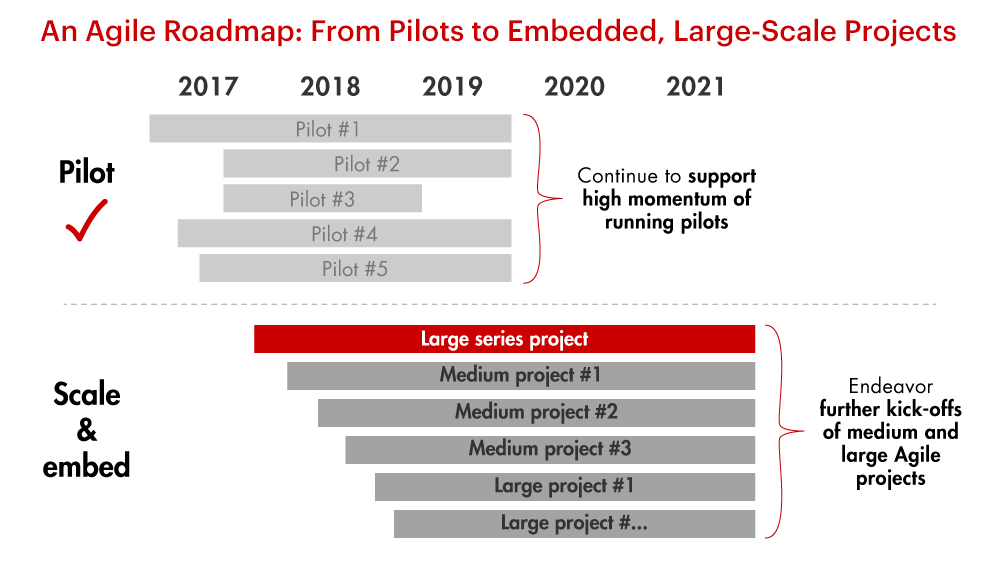The Situation
In the automotive sector, where new entrants are disrupting every segment from small cars to trucks and buses, the average product life cycle has shortened from roughly eight years to four over the past decade. AutoCo was not only failing to keep pace in launching new vehicles, but its efforts to do so were consistently over budget, sometimes by more than 25%.
Agile development presented a possible solution to AutoCo’s innovation dilemma. Deployed correctly, small, multidisciplinary, entrepreneurial teams could streamline complex tasks and projects and adapt quickly to new market opportunities.
With deep expertise in Agile, including an exclusive partnership with Scrum Inc. and hundreds of certified Agile practitioners, Bain was ideally positioned to inject the many benefits of Agile into AutoCo’s innovation efforts and manufacturing processes.
It was clear, however, that this would be an ambitious and in some ways unique undertaking. AutoCo’s typical project size and complexity, highly rigid processes, complicated physical prototypes, intensive interactions with suppliers, and the other realities of designing and building large, complex vehicles posed numerous challenges. But the Bain team was confident that it could help AutoCo navigate these obstacles and implement Agile to arrive at faster, more efficient ways to get new products to market.
Our Recommendations
AutoCo and Bain explored how Agile could be a game-changer, a process that resulted in four key recommendations and actions.
- Introduce Agile basics. First, the Bain team helped employees and leaders at AutoCo learn about Agile and related methodologies through a series of workshops, an easy-to-access online platform and an Agile primer, in addition to team training. These tools ensured ease of replicability and promoted Agile within the company.
- Support pilot projects. Bain worked with AutoCo to identify and launch a series of appropriate Agile pilot projects. Bain directly supported these pilots, especially in the early phases, and provided a “scrum master,” or product owner, to ensure a deep base of Agile knowledge at each essential stage.
- Capture data. Frequent progress reports enabled Bain and AutoCo to jointly review results from the pilot projects, compare effectiveness, identify obstacles and make improvements. The cross-functional nature of the teams helped to propagate common Agile standards throughout the organization, while ensuring that all business functions were involved from the start.
- Scale. With the experience of several pilot projects under their belts, Agile-trained AutoCo teams worked with Bain and company leadership to introduce Agile and related methodologies throughout the organization. At full potential, Agile is projected to generate savings of up to 30% on small projects and 10% to 20% on larger projects. One team created a completely new vehicle from scratch in full scrum mode, which was released at a major international trade show. The development time clocked in at a record 18 months, vs. four-plus years following a conventional approach.
The Results
Bain helped AutoCo embrace Agile to a degree that, once the company scales it to its full potential, can help it solidify its market-leading status in several ways.
- Speed. By shifting to Agile, some processes can now be done in six weeks vs. six months.
- Motivation and education. Employees have come to embrace Agile and Scrum as a working mode. Their response was overwhelmingly positive to the Agile primer, an interactive website that served as a knowledge hub, and the overall process for developing their Agile capabilities.
- Customer centricity. Agile entails a high level of input from, and collaboration with, customers. As just one example, the vehicle developed from scratch was regarded as 100% customer-centric, as customer input and preferences influenced every element of design.
- Proof is in the pudding. By piloting the approach on a real-life car project, AutoCo and Bain facilitated on-the-job training, and sent a signal throughout the entire organization that Agile actually delivers tangible results.

* We take our clients' confidentiality seriously. While we've changed their names, the results are real.
